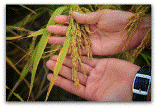Plant Pathology, Department of

Fungal Molecular Plant-Microbe Interactions
Date of this Version
2004
Document Type
Article
Citation
Journal of Applied Microbiology (2004) 97: 1,178-1,184. DOI: 10.1111/j.1365-2672.2004.02424.x
Abstract
Aims: To investigate how linoleic acid affects conidial production and sclerotial development in a strictly mitotic Aspergillus parasiticus field isolate as related to improving biocompetitivity of atoxigenic Aspergillus species.
Methods and Results: We disrupted A. parasiticus Δ12-oleic acid desaturase gene (odeA) responsible for the conversion of oleic acid to linoleic acid. We examined conidiation and sclerotial development of SRRC 2043 and three isogenic mutant strains deleted for the odeA gene (DodeA), either with or without supplementing linoleic acid, on one complex potato dextrose agar (PDA) medium and on two defined media: nitrate-containing Czapek agar (CZ) and Cove’s ammonium medium (CVN). The ΔodeA mutants produced less conidia than the parental strain on all media. Linoleic acid supplementation (as sodium linoleate at 0.3 and 1.2 mg ml-1) restored the ΔodeA conidial production comparable to or exceeding the unsupplemented parental level, and the effect was medium dependent, with the highest increase on CVN and the least on PDA. SRRC 2043 and the DodeA mutants were unable to produce sclerotia on CVN. On unsupplemented PDA and CZ, ΔodeA sclerotial mass was comparable to that of SRRC 2043, but sclerotial number increased significantly to two- to threefold. Supplementing linoleic acid to media, in general, tended to decrease wild type and ΔodeA sclerotial mass and sclerotial number.
Conclusions: Linoleic acid stimulates conidial production but has an inhibitory effect on sclerotial development. The relationship between the two processes in A. parasiticus is complex and affected by multiple factors, such as fatty acid composition and nitrogen source.
Significance and Impact of Study: Conditions that promote sclerotial development differ from those required to promote maximum conidial production. Manipulation of content and availability of linoleic acid at different fungal growth phases might optimize conidial and sclerotial production hence increasing the efficacy of biocompetitive Aspergillus species.

